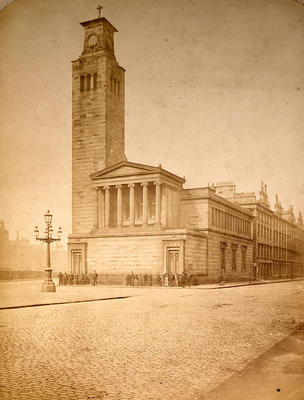Caledonia Road Church on:
[Wikipedia]
[Google]
[Amazon]
 Caledonia Road Church, formerly Caledonia Road United Presbyterian Church and Hutchesontown and Caledonia Road Church, is a ruined church in
Caledonia Road Church, formerly Caledonia Road United Presbyterian Church and Hutchesontown and Caledonia Road Church, is a ruined church in
 In 1963 the church use of Caledonian Road Church ended and the city of Glasgow took over the building. In October 1965, the church burned down after arson and was subsequently partially demolished. Since the 1990s, there have been various plans for the restoration and further use of the building, but these have not been implemented, and only necessary work to stabilise the building was carried out. The risk to the ruin is classified as high.
In 1963 the church use of Caledonian Road Church ended and the city of Glasgow took over the building. In October 1965, the church burned down after arson and was subsequently partially demolished. Since the 1990s, there have been various plans for the restoration and further use of the building, but these have not been implemented, and only necessary work to stabilise the building was carried out. The risk to the ruin is classified as high.
 Caledonia Road Church, formerly Caledonia Road United Presbyterian Church and Hutchesontown and Caledonia Road Church, is a ruined church in
Caledonia Road Church, formerly Caledonia Road United Presbyterian Church and Hutchesontown and Caledonia Road Church, is a ruined church in Glasgow
Glasgow is the Cities of Scotland, most populous city in Scotland, located on the banks of the River Clyde in Strathclyde, west central Scotland. It is the List of cities in the United Kingdom, third-most-populous city in the United Kingdom ...
, Scotland
Scotland is a Countries of the United Kingdom, country that is part of the United Kingdom. It contains nearly one-third of the United Kingdom's land area, consisting of the northern part of the island of Great Britain and more than 790 adjac ...
. In 1966 the building was added to the Scottish Heritage List as Category A.
History
The Scottish architect John Baird was responsible for the design. At that time, he ran a joint architectural office withAlexander Thomson
Alexander "Greek" Thomson (9 April 1817 – 22 March 1875) was an eminent Scottish architect and architectural theorist who was a pioneer in sustainable building. Although his work was published in the architectural press of his day, it was ...
. After the partnership broke up in 1856, Thomson continued the construction which had begun the previous year. On 22 March 1857 the church was opened. The total cost was about £8000.
 In 1963 the church use of Caledonian Road Church ended and the city of Glasgow took over the building. In October 1965, the church burned down after arson and was subsequently partially demolished. Since the 1990s, there have been various plans for the restoration and further use of the building, but these have not been implemented, and only necessary work to stabilise the building was carried out. The risk to the ruin is classified as high.
In 1963 the church use of Caledonian Road Church ended and the city of Glasgow took over the building. In October 1965, the church burned down after arson and was subsequently partially demolished. Since the 1990s, there have been various plans for the restoration and further use of the building, but these have not been implemented, and only necessary work to stabilise the building was carried out. The risk to the ruin is classified as high.
Description
The neoclassicalGreek Revival
Greek Revival architecture is a architectural style, style that began in the middle of the 18th century but which particularly flourished in the late 18th and early 19th centuries, predominantly in northern Europe, the United States, and Canada, ...
building stands at the junction of Gorbals Road ( A730) with Caledonian Road ( A728) in the Gorbals
The Gorbals is an area in the city of Glasgow, Scotland, and former burgh, on the south bank of the River Clyde. By the late 19th century, it had become densely populated; rural migrants and immigrants were attracted by the new industries and e ...
. The V-shaped streets closely enclose the church on both sides. On the southeast-facing façade, a portico in the style of Greek temple architecture with six Ionic columns emerges at gallery level. He sits on the massive church hall. This is where the two entrance portals are embedded. They are richly ornamented with Greek motifs and antefix
In architecture, an antefix () is a vertical block which terminates and conceals the covering tiles of a tiled roof (see imbrex and tegula, monk and nun). It also serves to protect the join from the elements. In grand buildings, the face of e ...
es. On the west side the building is nine, on the east side three axes wide. Only a short section of the gallery remains. The square tower on the west façade is designed on all sides near its end with open, narrow triplet windows. It is topped by a lantern surmounted by a cross.
References
External links
* {{DEFAULTSORT:Caledonia Road Church, Glasgow Churches in Glasgow Category A listed buildings in Glasgow Listed churches in Glasgow Churches completed in 1857 19th-century Presbyterian churches Alexander Greek Thomson buildings 19th-century church buildings in Scotland Gorbals Greek Revival church buildings in the United Kingdom 1857 establishments in Scotland